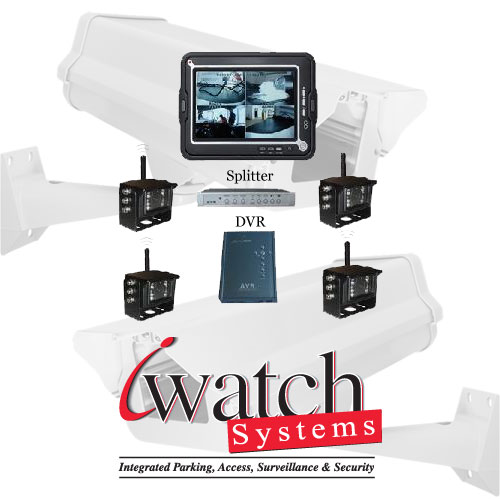iWatch Technical Experts View: How to choose a DVR for CCTV applications ?
1. Number of channels: Most DVRs are classified by the number of channels or cameras that can be connected. Typical configuration are 1,4,9 or 16 channels. Consider carefully how many cameras are required, both now and in the future. It is sensible to pay a little more now and have room for expansion at a later date.
2. Method of channel display. This is similar to the functions carried out by Switchers, Quads, and Multiplexers. A single channel recorder will probably not have any off these functions so will need the additional purchase of this type of unit.
The better DVRs have full multiplexers functions built into them. This is the desired type of product. A 4 channel DVR will split the screen into 4 and display one camera in each window. Similarly, a 9 channel DVR will give a 3 by 3 Matrix to display all the channels. All other functions of multiplexers like Alarm, Time and Date Stamping should be available.
3. Duration of Recording time: This will depend on the capacity of the hard drive. The more sophisticated units allow a number of user definable options. Typical settings allow the DVR to automatically start again at the beginning and record over the oldest data or the unit and indicate that it is full and the hard disk should be changed. It is preferable that the disks are mounted in slide out drawers to aid replacements.
By using video compression techniques it is possible to greatly extend the amount of data that can be stored on a hard drive. Similarly, by reducing the number of images per second that are recorded the capacity is increased. The concept DMR4 – MPEG – 4 product has a recording capacity of up to 6000 hours.
4. Maximum Frame Rate: This is maximum number of frames or images that can be recorded in a second. Traditional CCTV VCRs used low frame rates to achieve reasonable recording times from VHS Tape. This resulted in Jerky! Images. DVRs give the users the flexibility to choose the desired resolution.
If your application is simple to observe a person or vehicle entering an area than a frame rate as low as 1 per second is all that is required. To observe fine details of someone taking an item and putting it in their pocket then higher frame rates are needed. The most common DVR specification is 25 frames per second. DVRs with higher rates, 50, or 100 frames per second are only specified for very high end system specifications. Check the quoted frame refers to the British PAL system. Some specifications can be confusing in that they quote fields per seconds 50 fields per second = 25 frames per second.
5. Motion Detection: Depending on the application, it is not necessary to set the DVR to continually record. The better DVRs have a built in Motion Detection system this function is performed by electronically noting when the composition of the image changes and consequently setting the DVR to record mode. To ensure the required accuracy it should be possible to select the sensitivity of detection, typically at 256 levels. If this function is not included then it will be necessary to use traditional PIR sensors. Fitting PIRs means a lot of cabling and extra expense so it is often more cost effective to chose a DVR with motion detection.
6. Remote Set-up and viewing: The provision of an RS232 or RS485 interface allows the DVR to be connected to a PC and setup by the use of the keyboard. To connect to a LAN or the internet a web server is required. This can either be an optional extra or is already built-in.
7. Transferring recorded images: Choose from a number of options.
a) Remove hard disk and seal to the police or reviewer.
b) Copy from the DVR onto a conventional VCR tape.
c) Send across the LAN or Internet.
d) Use a network connection to a PC with a with a DVR burner.
e) Built-in CD Writer.
The latest addition of the DVR4-MPEG-4 makes digital recorders very affordable. It offers 4 channels and Multiplexer functions. It is now priced to be cheaper then some time-lapsed VCRs and as such should be considered a modern replacement for a VCRs. It has a selectable choice of frame rates to allow for long recording times. The built in Multiplexer functions include picture-in-picture and adjustable dwell times between channels. It can be triggered to record manually by an alarm from a PIR or on timer or using is motion detection function.
The concept DVRCD range is a digital multiplexer and recorder. 4, 8 and 16 channel versions are available with removable hard disks up to 1000 GB. The high frame rates and a choice of 4 levels of quality recording (Best,High,Normal,Basic) makes it a very versatile machine. The Jog/Shuttle control makes reviewing of images very easy. This product is ideal for home, school, shop, or business surveillance. This product is most suited to applications that require extensive reviewing of recorded images.








July 25th, 2010 at
Appreciate you sharing, great article post. Will read on…
July 25th, 2010 at
Thanks for appreciation. keep visiting our blogs and let us now if you have any suggestions. Thanks..
July 27th, 2010 at
That’s a funny Question on Technical Blog but I like to answer my question:
My Life, My Family and my Seniour members of Technical Supoort Team
You can also join us on few social networking sites like:
http://www.twitter.com/iwatchsystems
http://www.facebook.com/profile.php?id=100001194241924
http://www.linkedin.com/in/iwatchsystems
August 2nd, 2010 at
In looking for sites related to internet hosting and specifically comparison hosting linux approach world-wide-web, your internet site came up. You are a extremely smart person!
August 3rd, 2010 at
Thanks For Appreciation! You may post your suggestion on iwatchsystems.com
August 4th, 2010 at
Hello. Good task. I did not expect this on a Wednesday. That is a excellent story. Many thanks!
August 4th, 2010 at
Hi, there. This is a very extraordinary web site and some beneficial ideas as part of your article. I’ll be in turn. Thanks to the very good articles. By the way, why not listing your website in our E-Commerce directory and obtain a to come back link from us?
August 4th, 2010 at
Hi. Thanks a lot for appreciation. Surprise is always loved by everyone. right??
thanks again. keep visitng the blog, I will love to hear your comments and suggestions.
You can also join us on few social networking sites like:
http://www.twitter.com/iwatchsystems
http://www.facebook.com/profile.php?id=100001194241924
http://www.linkedin.com/in/iwatchsystems
December 27th, 2011 at
home security systems reviews…
[…]iWatch Technical Experts View: How to choose a DVR for CCTV applications ? | Security System Technology[…]…